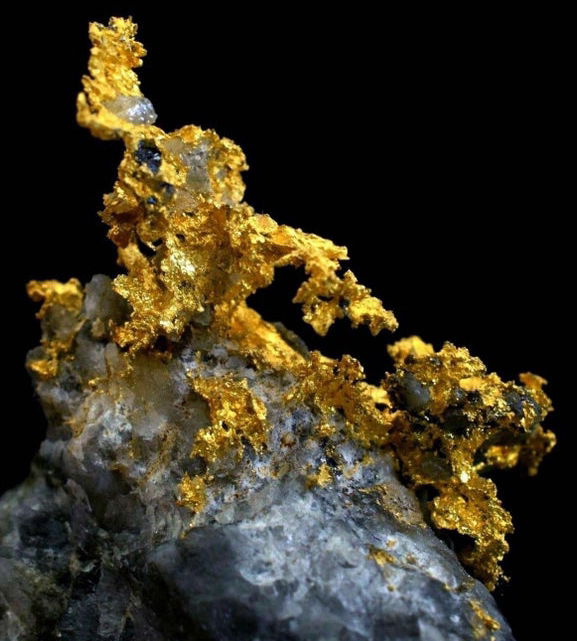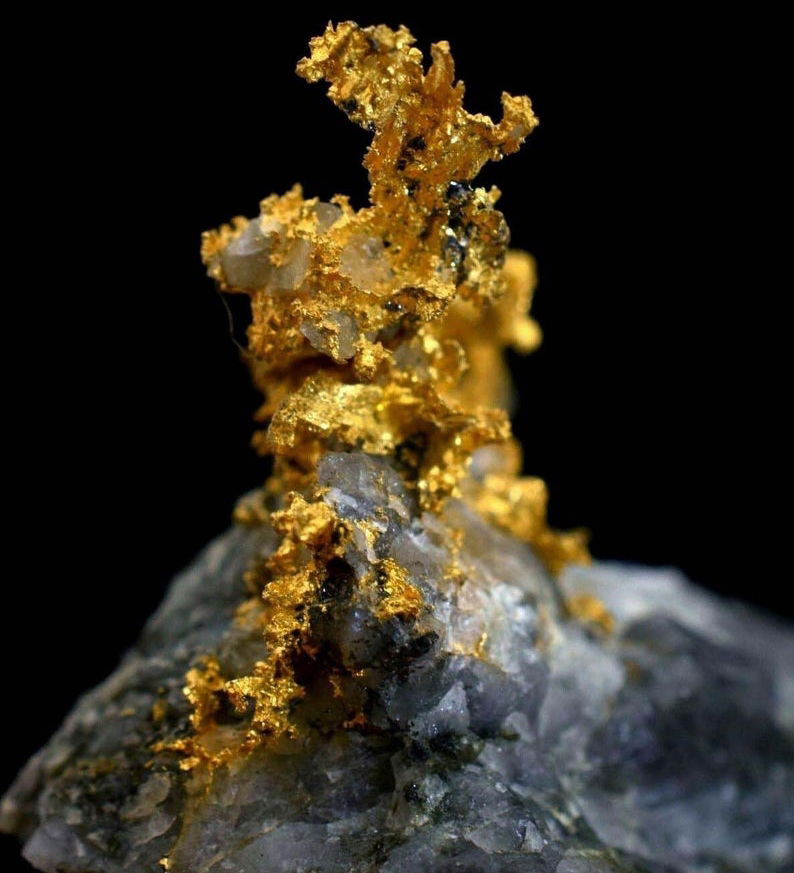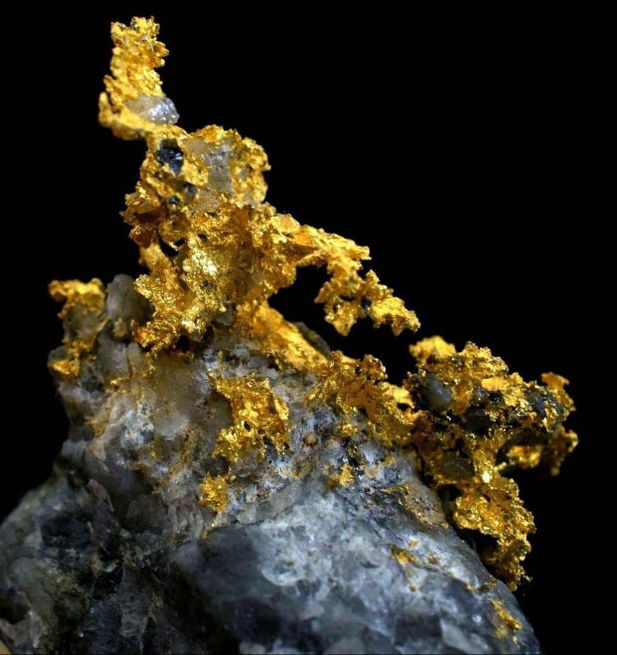GOLD OF THE ANDES, GEOCHEMISTRY, GENESIS AND HISTORY OF MAYAN DEPOSITS

GOLD OF THE ANDES, GEOCHEMISTRY, GENESIS AND HISTORY OF MAYAN DEPOSITS
By Dr Stephane D Ganay. Geological Engineer . Mineralogist / Micro'-mineralogy. Metallogeny of rare elements.
The gold deposits of the Andes are considered to be among the richest in the world in terms of gold production. Pre-Columbian civilizations including the Maya, Inca, and Chimu exploited these mines on a large scale to extract gold. Andean gold mines were located in the Andes mountains at high altitudes, which made mining difficult and dangerous. Miners used rudimentary techniques such as picks and shovels to extract gold from auriferous veins.
The quality of the gold extracted from the Andean mines was exceptional. The gold was often very pure, with a gold content of over 90%. This high quality has made Andean gold a very popular currency in trade between the different civilizations of the Andes.
With regard to the chemical analysis of Andean gold, the gold extracted from Andean mines was mainly in the form of nuggets, flakes and grains of varying size. Chemical analysis of Andean gold revealed a very high gold content, with a concentration of metals such as silver, copper, iron, lead and zinc. Andean gold mines also produced minerals such as pyrite, chalcopyrite and galena.
The use of gold extracted from Andean mines was mainly for religious and ornamental purposes. The Mayans, Incas and Chimu believed that gold had magical properties and could be used to communicate with the gods. Gold was used to make ritual objects such as statues, masks and jewelry. Andean civilizations believed that gold had healing properties and could be used to cure illnesses.
In terms of gold production, it is difficult to provide accurate data on the gold production of Andean mines in pre-Columbian times because the Andean civilizations did not have a modern measurement and accounting system. However, estimates suggest that Andean mines produced significant amounts of gold. For example, according to estimates, the Inca Empire produced around 20 tons of gold per year at its peak.
In terms of its relation to mythology, gold had an important place in the beliefs and religious practices of Andean civilizations.
The Mayans, Incas and Chimu believed that gold was sacred and had magical properties, and could be used to communicate with the gods. Gold objects were considered offerings to the gods and were used in religious ceremonies.
The relationship between Andean gold and mythology is also reflected in the legends and myths of Andean civilizations. For example, the Inca legend of Manco Capac tells that the gods created man out of gold and sent him to Earth to rule men. The Incas also believed that their emperor was a living god and that his body should be covered in gold to maintain its purity.
In terms of environmental impact, the mining of Andean gold deposits has had a significant impact on the environment. Miners used crude and often destructive techniques to extract gold, such as rock mining and the use of toxic chemicals to extract gold from rocks. This has led to the destruction of vast forest areas and the pollution of rivers and lakes.
Andean gold mines and deposits, particularly in Peru, have a long history and were exploited on a large scale by pre-Columbian civilizations such as the Mayas, Incas and Chimu. The gold extracted from the Andean mines was of exceptional quality and was used for religious and ornamental purposes. Gold had an important place in the beliefs and religious practices of Andean civilizations, and was considered sacred and had magical properties. However, the mining of Andean gold deposits has also had a significant impact on the environment.

GEOCHEMISTRY AND MINERAL PARAGENESE OF ANDEAN GOLD.
Gold geochemistry in the Peruvian Andes is a very complex and fascinating subject that involves a thorough understanding of regional geology, mineralogy and fluid chemistry. In this answer, I will attempt to give a general overview of gold geochemistry in this region, with emphasis on mineral associations, grades, and geological environments.
Gold in the Peruvian Andes is often associated with arsenate minerals, such as orpiment (As2S3) and realgar (AsS), as well as sulphides, such as pyrite (FeS2), sphalerite (ZnS) and chalcopyrite (CuFeS2). Gossans, also known as jarosite (KFe3(SO4)2(OH)6), is another mineral associated with gold in this region. Sylvanite (AgAuTe4) and mispickel (FeS2) are also mineral species associated with gold in the Peruvian Andes.
Gold grades in deposits vary considerably, ranging from a few grams per tonne to several hundred grams per tonne. The highest grades are often associated with shearing and fracturing zones that have allowed the circulation of sulfur-rich gold-bearing fluids. The highest concentrations of gold are often found in transition zones between acid rocks (granites) and basic rocks (basalts).
The chemical and petrographic environment in which gold is formed in the Peruvian Andes is complex and varies depending on the local geology. In many gold deposits, gold is associated with hydrothermal alteration of volcanic and sedimentary rocks. The hydrothermal fluids that circulated in these environments had high temperatures (200-300°C) and high pressures (2-3 kilobars), and were rich in sulfur and arsenic. When these fluids reacted with host rocks, they caused hydrothermal alterations that led to the formation of gold-bearing minerals.
The genesis and paragenesis of gold deposits in the Peruvian Andes are also complex and vary according to the local geology. In many deposits, gold is associated with sulphide minerals such as pyrite, sphalerite and chalcopyrite, which formed in sulphur-rich environments.
These sulfide minerals formed from sulfur-rich hydrothermal fluids that circulated through the host rocks. Gold was then deposited from these fluids when favorable pressure and temperature conditions were reached. In some deposits, gold is also associated with arsenate minerals such as orpiment and realgar, which formed in arsenic-rich environments. These arsenate minerals formed from arsenic-rich hydrothermal fluids that reacted with host rocks.
The paragenesis of gold deposits in the Peruvian Andes can be very complex, as gold can be associated with many other minerals, in addition to the sulphides and arseniates mentioned above. In some deposits, gold is associated with oxide minerals such as goethite (FeOOH) and limonite (Fe2O3 nH2O), as well as carbonates such as calcite (CaCO3) and dolomite (CaMg(CO3) 2). In other deposits, gold is associated with telluride minerals such as calaverite (AuTe2) and krennerite (AuTe2). The minerals associated with gold in the gold deposits of the Peruvian Andes can therefore vary considerably depending on the local geology.
Mineralogy and fluid chemistry. Gold in this region is often associated with sulphide, arseniate and telluride minerals, and gold grades vary considerably from deposit to deposit. The genesis and paragenesis of gold deposits in the Peruvian Andes are also complex and vary according to the local geology.

GEOLOGY
The history of gold formation in the Andes is linked to the geological history of the region, which is characterized by a long history of tectonic and volcanic activity. Gold in the Andes is primarily associated with hydrothermal deposits formed from hot, sulfur-rich fluids that have flowed through fractures and faults in host rocks.
The Andes are a mountain range that stretches over 7,000 km along the west coast of South America, at elevations ranging from sea level to over 6,000 meters. Gold deposits in the Andes are often found in the transition zones between acid rocks (granites) and basic rocks (basalts).
The history of gold formation in the Andes begins several hundred million years ago, when the Nazca tectonic plate began to subduct beneath the South American plate, creating a subduction zone along off the west coast of South America. This subduction caused the rocks of the subducted plate to partially melt, forming magmas that gave rise to granitic intrusions and volcanoes along the Andes chain.
Over the next millions of years, tectonic and volcanic activity in the Andes promoted the circulation of sulfur-rich hydrothermal fluids through fractures and faults in host rocks. These fluids reacted with the host rocks, causing hydrothermal alterations that led to the formation of gold-bearing minerals.
Gold in the Andes is also associated with hydrothermal alteration of volcanic and sedimentary rocks, which formed from hydrothermal fluids rich in arsenic and sulfur. These fluids reacted with the host rocks, resulting in the formation of gold-bearing minerals such as orpiment and realgar.
As for the altitudes where gold is found in the Andes, it varies greatly depending on the local geology. Most gold deposits in the Andes are found at elevations between 1,000 and 4,000 meters, although there are also gold deposits at higher elevations. The largest gold deposits are often found in areas of mountainous relief, where the rocks have been subjected to strong tectonic forces.
ALLUVIAL GOLD OF THE ANDES.
The alluvial study of Andean gold involves the examination of rivers and regions where gold is present in alluvial deposits.
Here are some of the major rivers and gold-bearing regions of the Andes:
1. The Madre de Dios River: Located in the Madre de Dios region of Peru, this river is one of the most important sources of alluvial gold in the Andes.
2. The Napo River: This river originates in Ecuador and flows through Peru and Colombia. It is known for its significant gold deposits.
3. The Marañón River: This river originates in the Peruvian Andes and crosses northeastern Peru before emptying into the Amazon in Brazil. It is known for its alluvial gold deposits.
4. La Rinconada region: Located in the Peruvian Andes, this region is considered the highest city in the world. It is also famous for its artisanal gold mining.
5. The Zaruma region: Located in Ecuador, this region is known for its surface and underground gold mines.
6. The Segovia region: Located in Colombia, this region is known for its surface and underground gold mines.
7. The Chocó region: Located on the Pacific coast of Colombia, this region is known for its important deposits of alluvial gold.
8. The Cauca River: This river crosses Colombia and is known for its important deposits of alluvial gold.
9. The Magdalena River: This river is the longest in Colombia and crosses vast gold-bearing regions. It has been an important transportation route for gold and other precious commodities since pre-Columbian times.
10. Tarkwa region: Located in Ghana, this region is known for its surface and underground gold mines.
11. The Cajamarca region: Located in the Peruvian Andes, this region is known for its gold and silver mines, but it is also famous for the social protest linked to large-scale mining.
12. The La Libertad region: Located in northern Peru, this region is known for its gold and silver mines. It is also famous for the colonial town of Trujillo, which was one of the main centers of Moche culture.
13. The Antioquia region: Located in Colombia, this region is known for its important gold and silver mines. It is also famous for the colonial city of Santa Fe de Antioquia.
14. The Huaypetue River: This river is located in the Madre de Dios region of Peru and is known for its large deposits of alluvial gold.
15. The San Cristobal region: Located in Bolivia, this region is known for its silver mines, but it also contains gold deposits.
These examples represent only a small fraction of the rivers and gold regions of the Andes. Artisanal and large-scale gold mining is an important industry in many parts of the Andes, and it is often associated with complex environmental and social issues.
HYDROGEOLOGY OF GOLD IN THE ANDES.
The complex hydrogeological study of the presence of alluvial gold in the Andes involves an understanding of erosion phenomena and fossil alluvial deposits, as well as the geological and hydrological factors that contributed to the formation of these deposits.
The water cycle is a key element in the hydrogeology of the gold-bearing regions of the Andes. The abundant rainfall in the Andes mountains feeds the rivers that flow through the gold regions, where the erosion of rocks and soil releases gold particles. These particles are transported by rivers downstream, where they settle in areas where water velocity decreases, such as sandbanks and riverbeds.
Fossil alluvial deposits are ancient deposits that were formed by past river systems. These deposits are often rich in minerals, including gold, and have been formed by processes such as erosion, transport and deposition of materials by ancient waterways. Fossil alluvial deposits are often covered by layers of more recent sediments, but they can be exposed by erosion of the upper layers.
The geology of the gold-bearing regions of the Andes is also important in understanding the presence of alluvial gold. The Andes are a young and active mountain range, characterized by intense tectonic activity. The movements of the tectonic plates have caused the formation of faults and fractures in the rocks, which can be conduits for hydrothermal fluids rich in minerals, including gold. These fluids can move through rocks and settle in porous and permeable rock layers, where they form underground gold deposits.
In addition, volcanic activity in the Andes has also contributed to the formation of gold deposits. The volcanic eruptions released mineral-rich hydrothermal fluids, which penetrated the surrounding rocks and were deposited in cracks and faults to form gold deposits.
In sum, the presence of alluvial gold in the gold-bearing regions of the Andes is the result of complex geological and hydrological factors, including erosion, transport and deposition of gold particles by rivers, the formation of deposits of underground gold by hydrothermal fluids, and the formation of mineral-rich fossil alluvial deposits. Gold mining in these regions can be done in different ways, ranging from small-scale artisanal mining to large-scale industrial mining.
Artisanal gold mining often involves the use of manual techniques, such as panning or shoveling, to recover gold from alluvial deposits. This form of mining is often practiced by local communities and can be an important source of income for rural populations. However, it can also have negative impacts on the environment, including land degradation and pollution of rivers through the use of mercury to separate gold from other minerals.
Industrial gold mining involves the use of advanced machinery and technology to extract gold from underground deposits or large-scale alluvial deposits. This form of mining can have significant environmental impacts, including the destruction of natural habitats, land degradation, pollution of rivers and aquatic ecosystems, and the production of toxic waste such as cyanide.
The presence of alluvial gold in the gold-bearing regions of the Andes is the result of complex geological and hydrological processes, and its mining can have significant impacts on the environment and local communities. Efforts to reduce the environmental impacts of gold mining include the development of cleaner technologies, environmental regulation, and the promotion of sustainable practices in artisanal and large-scale mining.
Dr Stephane D Ganay. Geological Engineer . Mineralogist / Micro'-mineralogy. Metallogeny of rare elements. Metalogeny of radionuclides. metallogenesis of ancient civilizations. Researcher in Major Risks. / ISBN 844359. - 0008. 2023.


